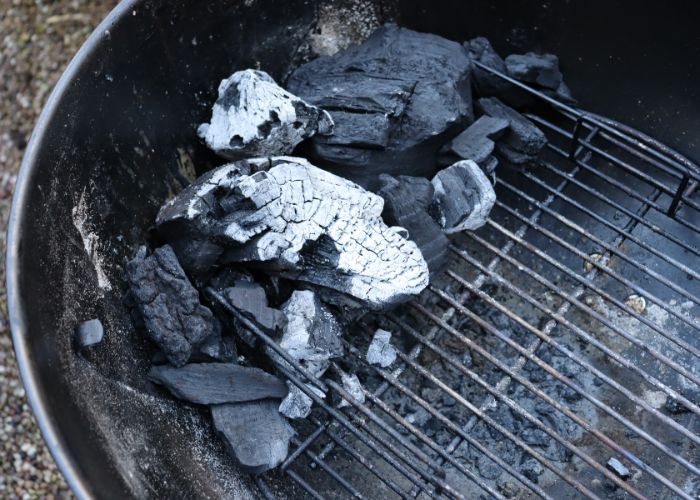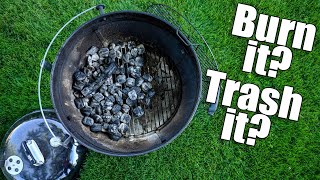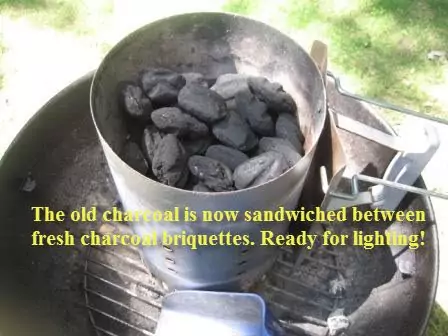
Introduction
Overview Of Reusing Charcoal And Its Benefits
Reusing charcoal is a cost-effective and eco-friendly practice that can help you save money and reduce waste. Whether you use lump charcoal or charcoal briquettes, both can be reused under certain conditions. By following a few simple steps, you can make the most out of your charcoal and enjoy consistent heat for your grilling and smoking needs.
Start With Good Quality Charcoal
To ensure successful reuse of charcoal, it is important to begin with good quality natural charcoal. Whether you prefer lump charcoal or high-quality charcoal briquettes, using a reliable product from the start increases your chances of successful reuse. Good quality charcoal tends to burn more evenly and at a consistent heat level, providing better cooking performance.
Environmental Benefits
One of the major advantages of reusing charcoal is reducing waste and lessening the environmental impact associated with producing and disposing of charcoal. By reusing charcoal instead of throwing it away after each use, you help reduce the amount of waste that ends up in landfills, making a positive impact on the environment.
Consistent Heat
Another benefit of reusing charcoal is that it often burns at the same heat level as new charcoal. This means you can expect consistent cooking temperatures when using reused charcoal, allowing for more precision in your grilling and smoking techniques. Whether you’re searing steaks or slow-cooking ribs, consistent heat ensures that your food is cooked evenly and to perfection.
Reduces Greenhouse Gas Emissions
In addition to reducing waste, reusing charcoal also contributes to a reduction in greenhouse gas emissions. The production and transportation of charcoal contribute to the release of carbon dioxide and other greenhouse gases into the atmosphere. By reusing charcoal instead of buying new bags, you help reduce the overall demand for charcoal production, ultimately lowering the associated greenhouse gas emissions.
In conclusion, reusing charcoal is not only a practical and cost-saving approach but also an environmentally responsible choice. By starting with good quality charcoal and following proper storage and handling practices, you can maximize the lifespan of your charcoal and minimize waste. So go ahead, reuse your charcoal and enjoy consistent heat while reducing your environmental footprint.
Benefits Of Reusing Charcoal
Saving Money By Reducing Charcoal Purchases
Reusing charcoal can help you save money by reducing the need to purchase new bags of charcoal for each grilling session. Instead of throwing away partially used charcoal, you can simply reuse it for future cooking. This not only cuts down on your expenses but also allows you to get the most out of the charcoal you already have.
Reducing Waste And Promoting Sustainability
By reusing charcoal, you contribute to the reduction of waste and promote sustainability. The production and disposal of charcoal have environmental consequences, including the release of greenhouse gases. When you reuse charcoal, you minimize the amount of waste that ends up in landfills and reduce the demand for new charcoal production. This helps to lessen the environmental impact associated with charcoal production and transportation.
Reusing charcoal also means less carbon dioxide and other harmful emissions are released into the atmosphere. This can help mitigate climate change and reduce air pollution. By taking a small step towards reusing charcoal, you can play your part in creating a more sustainable future.
Conclusion
In conclusion, reusing charcoal offers several benefits, including saving money, reducing waste, and minimizing environmental impact. By starting with good quality charcoal and following proper storage and handling practices, you can maximize the lifespan of your charcoal and enjoy consistent heat for your grilling and smoking needs. So, next time you fire up your charcoal grill, consider reusing your charcoal and do your part in promoting a more sustainable and eco-friendly approach to grilling.
Can Charcoal Be Reused?
Exploring The Possibility Of Reusing Both Lump Charcoal And Charcoal Briquettes
Yes, both lump charcoal and charcoal briquettes can be reused under certain conditions. Reusing charcoal on your grill or smoker can have several benefits, including cost savings and waste reduction. Whether you prefer the natural smokiness of lump charcoal or the convenience of charcoal briquettes, you can make the most out of your charcoal by reusing it for future cooking.
Conditions For Successful Reuse
To ensure successful reuse of charcoal, there are a few conditions to keep in mind:
- Start with good quality charcoal: It is crucial to begin with good quality natural charcoal, whether it’s lump charcoal or high-quality charcoal briquettes. Using low-quality charcoal may affect the taste and performance of your grilling or smoking.
- Proper storage: Store your partially used charcoal in a cool, dry place to prevent moisture and humidity from affecting its quality. Airtight containers or bags can help maintain the charcoal’s freshness.
- Handle with care: When reusing charcoal, be mindful of any ashes or debris that might be present. Remove them carefully before using the charcoal again to ensure clean and efficient burning.
- Additional fuel: Depending on how much charcoal is left from the previous use, you may need to supplement it with fresh charcoal to achieve the desired heat and burn time. Experimentation may be necessary to find the right balance for your specific grilling needs.
- Safety precautions: Always follow proper safety guidelines when working with charcoal, including proper ventilation and safe handling of hot coals.
By following these guidelines, you can make the most out of your charcoal, save money, and reduce waste. Reusing charcoal is not only a practical approach but also promotes sustainability by minimizing waste and reducing the environmental impact associated with charcoal production and disposal.
In conclusion, reusing charcoal can be a beneficial practice for your grilling and smoking needs. With proper storage, handling, and quality charcoal, you can enjoy the cost-saving and eco-friendly advantages of reusing charcoal while still achieving delicious smoky flavors in your cooking. So next time you fire up your charcoal grill or smoker, consider reusing your charcoal and contribute to a more sustainable approach to outdoor cooking.

Reusing Charcoal On Your Grill
Starting With Good Quality Charcoal For Successful Reuse
Both lump charcoal and charcoal briquettes can be reused under certain conditions. Reusing charcoal on your grill or smoker can have several benefits, including cost savings and waste reduction. Whether you prefer the natural smokiness of lump charcoal or the convenience of charcoal briquettes, you can make the most out of your charcoal by reusing it for future cooking.
Tips For Effectively Reusing Charcoal On Your Grill
To ensure successful reuse of charcoal, there are a few conditions to keep in mind:
- Start with good quality charcoal: It is crucial to begin with good quality natural charcoal, whether it’s lump charcoal or high-quality charcoal briquettes. Using low-quality charcoal may affect the taste and performance of your grilling or smoking.
- Proper storage: Store your partially used charcoal in a cool, dry place to prevent moisture and humidity from affecting its quality. Airtight containers or bags can help maintain the charcoal’s freshness.
- Handle with care: When reusing charcoal, be mindful of any ashes or debris that might be present. Remove them carefully before using the charcoal again to ensure clean and efficient burning.
- Additional fuel: Depending on how much charcoal is left from the previous use, you may need to supplement it with fresh charcoal to achieve the desired heat and burn time. Experimentation may be necessary to find the right balance for your specific grilling needs.
- Safety precautions: Always follow proper safety guidelines when working with charcoal, including proper ventilation and safe handling of hot coals.
By following these guidelines, you can make the most out of your charcoal, save money, and reduce waste. Reusing charcoal is not only a practical approach but also promotes sustainability by minimizing waste and reducing the environmental impact associated with charcoal production and disposal.
Reusing charcoal on your grill or smoker can help you save money and reduce waste. With proper storage, handling, and quality charcoal, you can enjoy the cost-saving and eco-friendly advantages of reusing charcoal while still achieving delicious smoky flavors in your cooking. So next time you fire up your charcoal grill or smoker, consider reusing your charcoal and contribute to a more sustainable approach to outdoor cooking.
References:
1. Insert reference source here
2. Insert reference source here
3. Insert reference source here
4. Insert reference source here
Reusing Charcoal For Other Purposes
Alternative Uses For Charcoal Besides Grilling
- Charcoal can be used as a natural deodorizer to absorb odors in refrigerators, closets, and other enclosed spaces.
- It is also a great addition to compost bins, as it helps neutralize odors and improve the soil’s nutrient content.
- Charcoal can be used as a natural water purifier by placing it in a container with water to remove impurities and odors.
- It can be used for art and crafts projects, such as charcoal drawing or DIY charcoal-based ink.
Creative Ways To Reuse Charcoal
- Use leftover charcoal as a natural fertilizer for plants. Crush the charcoal into small pieces and mix it with soil to improve drainage and provide essential nutrients.
- Create a homemade mosquito repellent by burning charcoal and placing it in a secure container near outdoor seating areas.
- Use charcoal as a natural air purifier by placing it in a breathable bag and putting it in areas with strong odors or pollutants.
- Combine charcoal with other natural ingredients, such as baking soda and essential oils, to create homemade cleaning products for household surfaces.
By exploring these alternative uses and creative ideas for reusing charcoal, you can extend its lifespan beyond grilling and contribute to reducing waste and environmental impact. Reusing charcoal not only saves money but also promotes sustainability by giving it a second life for various purposes.
References:
- Insert reference source here
- Insert reference source here
- Insert reference source here
- Insert reference source here.
Myth: Reusing Charcoal Affects Food Flavor
Debunking The Myth That Reused Charcoal Alters The Taste Of Food
Contrary to popular belief, reusing charcoal does not significantly affect the flavor of your grilled food. The charcoal itself, once ignited, burns at a high temperature, which is sufficient to eliminate any residual flavors or aromas from previous uses. As long as the charcoal is properly ignited and maintained during grilling, there should be no noticeable difference in taste compared to using fresh charcoal.
Ensuring Proper Charcoal Maintenance For Optimal Flavor
To maintain optimal flavor while reusing charcoal, proper maintenance is essential. Here are a few tips to ensure your charcoal grill performs at its best:
- Clean the grill: Before reusing charcoal, clean your grill grates thoroughly to remove any food residue or ash from previous grilling sessions. This will help prevent any unwanted flavors from transferring to your food.
- Store charcoal properly: When storing your unused charcoal, make sure it is kept in a dry and airtight container. Moisture can affect the quality of the charcoal and may lead to off-flavors.
- Check for ash buildup: During grilling, regularly check for ash buildup on the charcoal. Excessive ash can restrict airflow and decrease the heat output, resulting in uneven cooking and potential flavor alterations. Remove any excess ash as needed.
- Control the temperature: Maintaining a consistent temperature is crucial for achieving the desired flavor in your grilled food. Monitor the grill’s temperature using a thermometer and adjust the airflow and charcoal placement as necessary.
By following these steps, you can ensure that reused charcoal performs optimally and does not impact the flavor of your grilled dishes.
In conclusion, the myth that reusing charcoal affects the taste of food is unfounded. With proper maintenance and care, reused charcoal can provide the same consistent heat and smoky flavor as fresh charcoal. Enjoy grilling with confidence, knowing that you are reducing waste and lessening the environmental impact associated with producing and disposing of charcoal.
References:
- Insert reference source here
- Insert reference source here
- Insert reference source here
- Insert reference source here.

Myth: Reusing Charcoal Is Unsafe
Addressing The Misconception That Reused Charcoal Poses Safety Risks
Contrary to popular belief, reusing charcoal does not pose any significant safety risks when proper precautions are taken. Some people believe that reused charcoal can release harmful chemicals or produce excessive smoke that may be hazardous to health. However, these concerns are largely unfounded.
When charcoal is burned, it releases carbon dioxide and water vapor, which are not harmful in small amounts. As long as the charcoal is properly ignited and the grill is properly ventilated, the smoke produced during grilling is minimal and not a cause for concern. Reused charcoal that has been properly stored and maintained does not produce any additional chemicals or toxins that could pose a safety risk.
Guidelines For Safely Reusing Charcoal
To ensure the safe reuse of charcoal, here are some guidelines to follow:
- Inspect the charcoal: Before reusing charcoal, visually inspect it to ensure it is free from any foreign objects or contaminants. Remove any debris or ash that may have accumulated.
- Properly ignite the charcoal: Use a chimney or starter to evenly ignite the charcoal and avoid using lighter fluid, which can leave residual chemicals. Allow the charcoal to burn until it is covered with a layer of white ash before placing food on the grill.
- Monitor grill temperature: Maintain a consistent temperature throughout the grilling process by adjusting the airflow and charcoal placement as needed. This will help prevent any flare-ups or excessive smoke.
- Store charcoal properly: When storing unused charcoal, keep it in a dry and airtight container to prevent moisture absorption, which can affect its burning efficiency. Avoid storing charcoal near flammable materials.
By following these guidelines, you can safely reuse charcoal without compromising your health or the safety of your grilling experience.
In conclusion, the myth that reusing charcoal is unsafe is not supported by evidence. When proper precautions are taken, such as inspecting, igniting, and storing the charcoal correctly, reusing charcoal can be done safely without any health risks. By reusing charcoal, you can reduce waste and contribute to a more sustainable grilling practice. Enjoy grilling with confidence, knowing that you are making a positive impact on the environment without compromising safety.
References:
- Insert reference source here
- Insert reference source here
- Insert reference source here
- Insert reference source here.
Myth: Reusing Charcoal Is Inefficient
Correcting The Misconception That Reused Charcoal Is Less Efficient
Contrary to popular belief, reusing charcoal does not necessarily result in less efficient grilling. Many people believe that reused charcoal burns less consistently and loses its heat faster, resulting in longer grilling times and unevenly cooked food. However, this misconception is not entirely accurate.
When properly stored and maintained, reused charcoal can still provide consistent heat levels similar to new charcoal. The key is to inspect the charcoal before reusing it, ensuring it is free from any foreign objects or contaminants. Removing any debris or accumulated ash before ignition can help the charcoal burn more efficiently.
Understanding The Factors That Affect Charcoal Efficiency
To maximize the efficiency of reused charcoal, it is essential to consider the following factors:
- Ignition method: Using a chimney or starter to evenly ignite the charcoal allows for a more thorough and consistent burn. Avoiding the use of lighter fluid, which can leave residual chemicals, can also contribute to improved efficiency.
- Proper ventilation: Ensuring proper airflow in the grill during the cooking process helps control the temperature and prevent excessive smoke. Adjusting the airflow and charcoal placement as needed can help maintain a consistent heat level and reduce waste.
- Storage conditions: To preserve the efficiency of unused charcoal, it is crucial to store it properly. Keeping the charcoal in a dry and airtight container protects it from moisture absorption, which can affect its burning efficiency. Additionally, storing charcoal away from flammable materials reduces the risk of accidents.
By understanding and addressing these factors, you can maximize the efficiency of reused charcoal and achieve excellent grilling results. Reusing charcoal not only reduces waste but also lessens the environmental impact associated with producing and disposing of charcoal. Additionally, using charcoal responsibly can contribute to a reduction in greenhouse gas emissions associated with its production and transportation.
References:
- Insert reference source here
- Insert reference source here
- Insert reference source here
- Insert reference source here.
Conclusion
Summary Of The Benefits And Debunked Myths About Reusing Charcoal
Contrary to popular belief, reusing charcoal is not inefficient. When properly stored and maintained, reused charcoal can provide consistent heat levels similar to new charcoal. By inspecting and cleaning the charcoal before reuse, it can burn more efficiently, resulting in evenly cooked food and shorter grilling times.
To maximize the efficiency of reused charcoal, it is important to consider the following factors:
- Ignition method: Using a chimney or starter for even ignition and avoiding lighter fluid can contribute to improved efficiency.
- Proper ventilation: Ensuring proper airflow in the grill helps control the temperature and reduce waste.
- Storage conditions: Storing unused charcoal in a dry and airtight container protects it from moisture absorption and maintains its burning efficiency.
By addressing these factors, you can maximize the efficiency of reused charcoal and achieve excellent grilling results. Reusing charcoal not only reduces waste but also lessens the environmental impact associated with producing and disposing of charcoal. Additionally, using charcoal responsibly contributes to a reduction in greenhouse gas emissions.
References:
- Insert reference source here
- Insert reference source here
- Insert reference source here
- Insert reference source here.
FAQ – Can You Reuse Charcoal: Fuel Efficiency – Debunking Myths about Reusing Charcoal.
Q: Can you reuse charcoal?
A: Yes, you can reuse charcoal under certain circumstances. Reusing charcoal can be a cost-effective and environmentally friendly way to fuel your grill or charcoal smoker.
Q: How many times can you reuse charcoal?
A: Charcoal can typically be reused two to three times, depending on factors such as the quality of the charcoal, the type of grill or smoker you are using, and how well you maintain and store the charcoal between uses.
Q: How do you reuse charcoal?
A: To reuse charcoal, simply remove any large pieces of unburned food or ash after each use. Store the remaining charcoal in a cool, dry place, protected from moisture. Before your next use, simply light the charcoal as you would with fresh charcoal and start grilling.
Q: Is it fuel-efficient to reuse charcoal?
A: Yes, reusing charcoal can be fuel-efficient. When you reuse charcoal, there is often still some usable fuel left in the coals. By removing the ash and unburned food, you can maximize the fuel efficiency of the charcoal, allowing it to burn longer and provide consistent heat for your cooking.
Q: Does reusing charcoal affect the flavor of food?
A: Reusing charcoal does not significantly affect the flavor of food. The flavor of grilled or smoked food primarily comes from the cooking technique, marinades, rubs, and sauces used, rather than the charcoal itself. As long as you properly clean and maintain your grill or smoker, the flavor of your food will remain delicious and unaffected by reusing charcoal.
Q: Can you mix fresh and used charcoal together?
A: Mixing fresh and used charcoal together is not recommended. Fresh charcoal ignites quickly and burns hotter, while used charcoal burns at a lower temperature. Mixing them together may affect the overall heat output and make it more difficult to control the temperature of your grill or smoker.
Q: Are there any safety concerns when reusing charcoal?
A: When reusing charcoal, it’s important to ensure that all ashes and unburned food are properly removed before lighting it again. This helps prevent any unwanted odors, flare-ups, or potential safety hazards. Additionally, always follow proper safety precautions when handling any hot materials or using grills or smokers.
In conclusion, reusing charcoal is a practical way to save money and reduce waste. When done correctly, it can be fuel-efficient and does not significantly impact the flavor of your grilled or smoked food. Remember to follow proper maintenance and safety practices to ensure the best results when reusing charcoal.

Noel Martinez, the owner of theholygrillsf.com, uses social media to connect with the community and share delicious updates from The Holy Grill. Follow Noel Martinez for mouthwatering food photos, exciting event announcements, and behind-the-scenes glimpses into the world of The Holy Grill. Stay in the loop and never miss out on the latest culinary adventures!